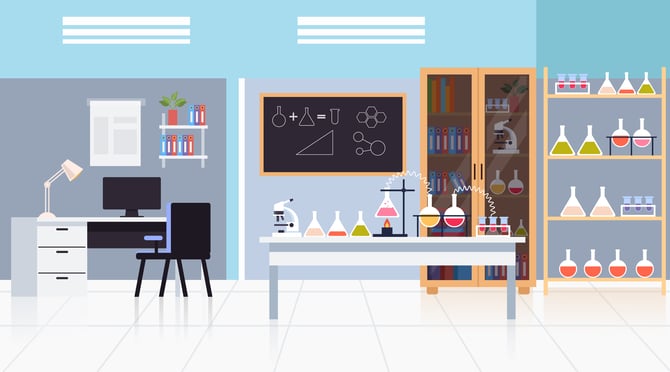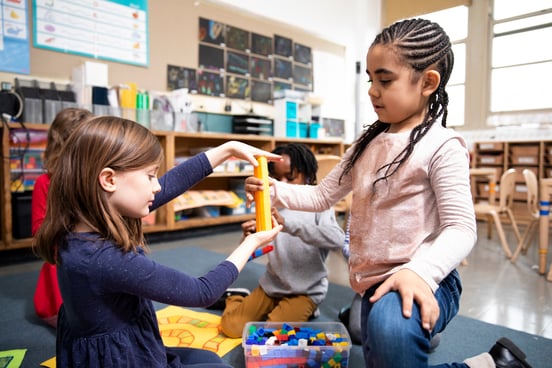
5 Easy Math Engagement Strategies for the Classroom
The news headlines are daunting. Math scores are down. School districts are scrambling to turn things around. And...
ALI Staff | Published June 16, 2023
The science lab is a fun and exciting place for students. It’s where they get hands-on with science and learn how to conduct an experiment.
It’s also a place with much potential for accidents.
Any time students participate in a lab setting, a new set of safety rules come into play, and implementing and following those rules are necessary for a positive learning experience.
For a science lab to effectively engage students in science, there must be clear and understandable lab safety rules to follow.
Science safety is very serious, and it’s up to you to make sure students are in the “know” about everything from science safety symbols to the specific lab rules.

Creating science safety rules for your lab requires much more work than just writing out a list of dos and don'ts.
Thought into science safety should start before any supplies are purchased and the lab is fully set up.
Rather than simply making a list of chemicals you’ll need in the lab, think about how safe what you want to have in the lab is for students.
Where will you store them? How will you ensure they’re kept out of reach of students? How ventilated is the area where they’ll be used? How will you safely dispose of these chemicals when the class uses them?
All of these questions must be thought about before bringing potentially harmful materials into the science lab.
Thinking about lab safety rules also means working backward to decide what safety equipment the lab will need.
This includes everything from proper gear like safety goggles and lab coats to Bunsen burners and appropriate glassware.
Once you’ve created a safe environment with the correct materials, the next step is to develop actual safety procedures.
Science lab safety rules are essential, but you must do more than just create a list and post it in the classroom.
To ensure safety is enforced, have students read and sign a lab safety contract. Make this as detailed as possible.
Once every student signs, review safety procedures, like what to do if you get anything in your eye or spill an abrasive chemical.
Create a routine students will follow each time they enter the lab that begins with collecting proper safety equipment and reviewing the lab activity before starting to avoid making any dangerous mistakes.
Science safety is complex but necessary since protecting your students without causing massive interruptions to learning is essential for a successful science lab.
Some lab rules will feel like common sense.
Rules like no horseplay in the lab or no food or drink in the lab seem like no-brainers, but it’s worthwhile to get really detailed when making your list of dos and don’ts.
This ensures students have a uniform understanding of your expectations in the lab, with established practices for everything from handling very hot or very cold materials down to what kind of footwear is required in the lab.
Establishing these expectations can help provide the safe learning environment we all want students to have.
It’s also important for students to understand science safety symbols and how to respond to them.
If they see a flammable symbol on a chemical, they need to know to keep it away from the Bunsen burner when it’s on.
As you have your students sign a safety contract, consider giving them a quiz focusing on lab safety and what the most common symbols around the lab mean.
The other component of your science safety rules is what to do if an accident occurs.
Giving students a breakdown of what to do if XX happens, with mapped-out instructions, allows students to react appropriately when an accident occurs.
This means a smaller interruption to learning for everyone and quick and proper care being taken in the lab.
It keeps the learning environment safer and allows class time to continue after an incident without the panic and stress of not knowing what to do next.
You can’t go over these safety procedures too much, so consider quick reminders when different materials are brought out for a lab activity.
This gives students a refresher on what accidents can occur with the materials they use that day and how to deal with them.
There are five primary hazards students can encounter in the science lab:
Primary science safety rules ensure that all students use the right equipment properly to limit the risk of these hazards, but it’s not a perfect system.
Students don’t always ‘get it’ right away, and while you understand all the potential issues at hand, some of which will seem like common sense, your students may not.
Take the time to include hazardous risks in your lab practicum so students clearly understand why they need to wear protective gear or why they need to practice good chemical management.
If materials for a specific lab are more dangerous than normal, say if students are working with a corrosive element that can harm them severely, make sure they know that.
You aren’t scaring students if you let them know that getting sodium nitrite on their skin will burn them or that ethanol is highly flammable and can explode.
You’re educating them on the real danger if these chemicals are misused.
Students must take science seriously in the lab; understanding the possible hazards helps them realize that.
Educating students about lab safety rules makes sure they handle equipment and materials appropriately.
But, the final step to creating a safe lab environment is having the correct safety resources for the slim chance of an emergency.
These should include the following:
The lab should also have proper ventilation or a chemical fume hood to prevent inhalation of dangerous chemicals.
Also, if your lab has the space, adding a safety shower can help protect a student who comes into contact with a hazardous material on more than their hands and face.
Science safety does so much more than protect our students.
It helps maintain the environment, so the focus stays on learning and doing science.
Students can stay connected to the work, and you can stay focused on teaching, rather than everyone worrying about an accident (and injury) lurking around every corner.

The news headlines are daunting. Math scores are down. School districts are scrambling to turn things around. And...

Math assessment in California is changing. What used to be a compliance exercise or reporting tool is now becoming a...

You know the moment: a student’s eyes light up when the science experiment fizzes or the math puzzle helps them...